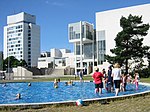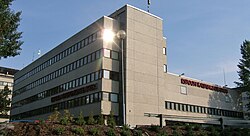Tapiola

Tapiola (Finnish: [ˈtɑpiolɑ]; Swedish: Hagalund) is a district of the municipality of Espoo on the south coast of Finland, and is one of the major urban centres of Espoo. It is located in the western part of Greater Helsinki. The name Tapiola is derived from Tapio, who is the forest god of Finnish mythology, especially as expressed in the Kalevala.Tapiola was largely constructed in the 1950s and 1960s by the Finnish housing foundation and was designed as a garden city. It is the location of the Espoo cultural centre, the Espoo Museum of Modern Art (EMMA), the Espoo city museum, and the Espoo City Theatre. According to the Finnish National Board of Antiquities, Tapiola was the largest and most valuable example of the 1960s construction ideologies in Finland. Its architecture and landscaping that combine urban living with nature have attracted tourists ever since.
Excerpt from the Wikipedia article Tapiola (License: CC BY-SA 3.0, Authors, Images).Tapiola
Länsituuli, Espoo Tapiola (Suur-Tapiola)
Geographical coordinates (GPS) Address Nearby Places Show on map
Geographical coordinates (GPS)
| Latitude | Longitude |
|---|---|
| N 60.175555555556 ° | E 24.8025 ° |
Address
Länsituuli 4
02100 Espoo, Tapiola (Suur-Tapiola)
Finland
Open on Google Maps










